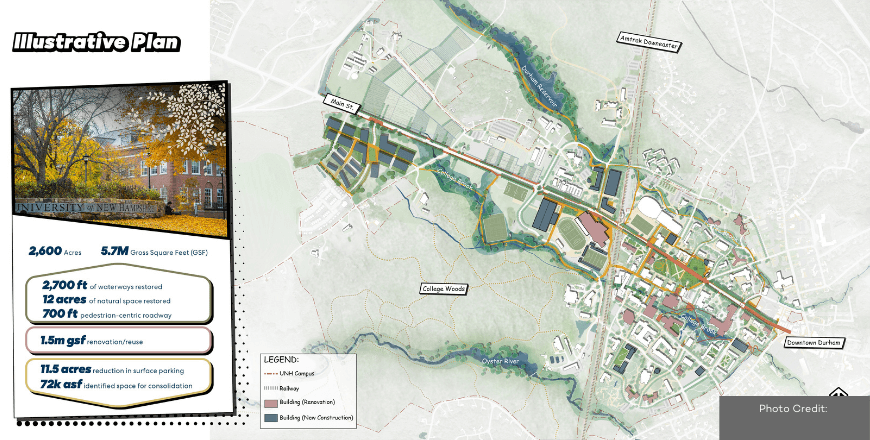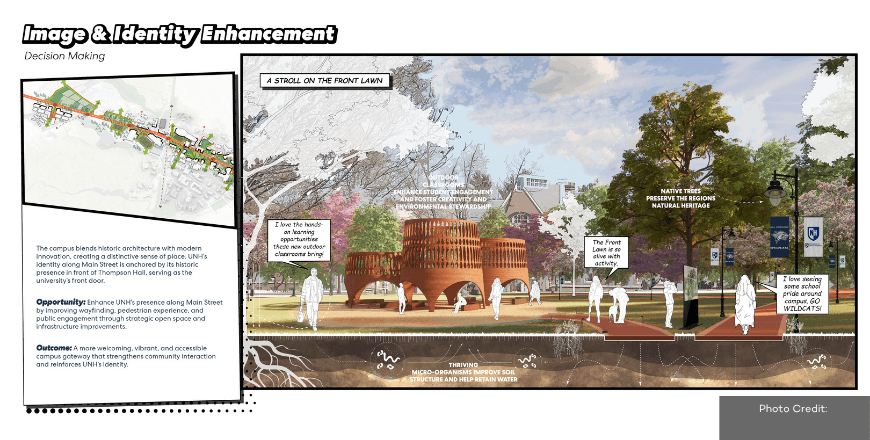- Integrated Planning
Integrated Planning
Integrated planning is a sustainable approach to planning that builds relationships, aligns the organization, and emphasizes preparedness for change.
- Topics
Topics
- Resources
Resources
Featured Formats
Popular Topics
- Events & Programs
Events & Programs
Upcoming Events
- Community
Community
The SCUP community opens a whole world of integrated planning resources, connections, and expertise.
- Integrated Planning
Integrated Planning
Integrated planning is a sustainable approach to planning that builds relationships, aligns the organization, and emphasizes preparedness for change.
- Topics
Topics
- Resources
Resources
Featured Formats
Popular Topics
- Events & Programs
Events & Programs
Upcoming Events
- Community
Community
The SCUP community opens a whole world of integrated planning resources, connections, and expertise.
Honor - Existing CampusUniversity of New Hampshire
University of New Hampshire: Campus as a Living System Jury Comments““. . . transforming the campus into a living system that restores natural processes and enhances biodiversity through renaturalization is bold and exemplary . . . reflects a thoughtful approach to restoring the connection between people, land, and nature . . . the Decarbonization Roadmap stands out as a compelling example of long-term environmental commitment and strategic planning . . .“”
Jury Comments““. . . transforming the campus into a living system that restores natural processes and enhances biodiversity through renaturalization is bold and exemplary . . . reflects a thoughtful approach to restoring the connection between people, land, and nature . . . the Decarbonization Roadmap stands out as a compelling example of long-term environmental commitment and strategic planning . . .“”Highlights
-
Site – 2,600 acres / 5.7 million gsf
-
The plan considers intercampus connections, external partnerships, and Durham’s unique role in the statewide system.
-
Nature, people, and the built environment were considered equally.
-
Physical transformations integrate the surrounding natural systems into the campus.
-
A Campus Planner Dashboard generates visuals and analysis for decision making.
-
A Decarbonization Roadmap details infrastructure goals, strategies, and actions.
-
The project reconsiders the campus’s Indigenous history and natural history.
-
The project sets clear targets for decarbonization and climate action.
Perspectives
This project is a comprehensive long-term campus master plan focused on sustainability and stewardship. It is a vision for the future of the campus, buildings, and grounds that responds to the university’s long-term functional, programmatic, aspirational, and technical needs. The master plan focuses on right-sizing the footprint of campus facilities to align with evolving needs and foster a sustainable future—environmentally, financially, and operationally. The vision for the campus is a living system—a dynamic interplay of natural, built, and human elements that shape the environment and the experiences of those who inhabit it. This perspective guides a design philosophy that prioritizes integration with nature, human connection, and timeless beauty, creating inspiring and enduring spaces. By prioritizing this integration, UNH can honor the enduring legacies of the Native American peoples who shaped and stewarded this region long before the university’s establishment.
Various tools and strategies ensured that the campus and community population had a chance to get their voices heard. The planning team sent an online survey to all students, faculty, and staff; the team spoke 1:1 with students and guided them through small charrette activities; individual and group interviews occurred with department or program leaders; focus group committees made up of subject matter experts from leadership to students and community members met throughout the process to provide insight and vet ideas; steering and executive committees met to review recommendations; and coordination took place at the system-wide level with teams planning other campuses within the university USNH system. The development of an innovative Campus Planner Dashboard served as a central element. This user-friendly interface synthesizes diverse data sources, offering insights into space utilization, capacity and demand projections, and building performance.
As a land grant institution, UNH’s mission is deeply connected to land stewardship. The master plan takes a long view of this responsibility, tracing the heritage back to pre-colonial times. The project considers the ways people historically interacted with nature. While people always acted on the land, it was a two-way partnership. Through studying the Indigenous history and engaging with representatives from the local Abenaki tribe, the plan prioritized solutions that strengthen the connection between developed and natural environments.
Project Team
Perkins&Will; RMF: Engineering, Site Infrastructure; Tighe Bond, Civil Engineering.


 1/3
1/3 - Topics
- Topics


